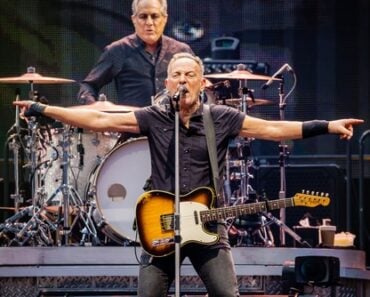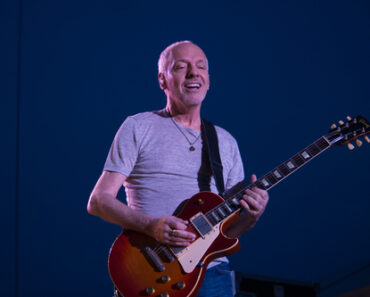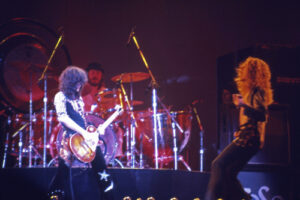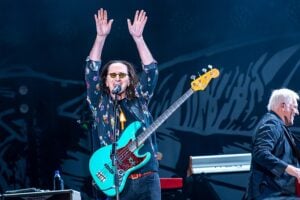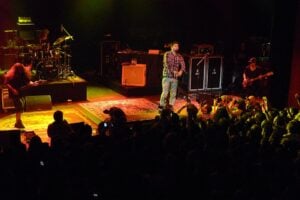Introduction: The Bell, The Rain, and The Roar
It began, as it had to, with the sound of rain, a tolling bell, and a thunderclap. For the 40,000 pilgrims gathered at Villa Park on Saturday, July 5, 2025, these were not mere sound effects; they were a sacred incantation. This was the opening to the song “Black Sabbath,” from the album Black Sabbath, by the band Black Sabbath—the foundational text of heavy metal. As the soundscape that birthed a genre washed over the stadium, it served as a powerful overture, a direct and unambiguous signal that this 10-hour marathon of music, billed as “Back to the Beginning,” was more than a concert. It was a full-circle journey, a final chapter to be written in the very soil from which the story first grew.
The day itself was a testament to the gravity of the occasion. The city of Birmingham, the soot-stained industrial heart of England that forged the band’s sound from factory clatter and working-class despair, had transformed into a global capital of metal. The streets were a sea of black t-shirts and battered denim, a uniform worn by a tribe that had traveled from every corner of the planet to pay its respects. This was a pilgrimage. Pubs were decked in purple and black, fans gathered for photos at the Black Sabbath Bridge mural, and the air buzzed with a “carnival atmosphere” that felt less like a somber farewell and more like a coronation. They were not there to mourn an ending, but to celebrate a creation.
This was the fundamental paradox and ultimate triumph of “Back to the Beginning.” It was an event meticulously designed to be the final, definitive statement on the careers of Ozzy Osbourne and Black Sabbath, yet it was suffused with the vibrant, chaotic energy of a genre still in its prime. It was a day that functioned on multiple levels simultaneously: a living museum of heavy metal, curated by its own architects; a family reunion for a global community; and an emotionally staggering act of personal and collective closure. While other farewells have marked rock history—the all-star tribute to a fallen hero at The Freddie Mercury Tribute Concert, the communal, guest-laden celebration of The Last Waltz, the historical summation of Live Aid—”Back to the Beginning” synthesized these templates into something new. It was a pre-mortem tribute, a living wake where the guests of honor were not only present but enthroned, able to witness and receive the love their legacy had generated. This was not just a concert; it was a self-aware monument, a final, thunderous amen to one of the most important stories in the history of rock and roll.
Part I: The Prince in Winter: Ozzy Osbourne’s Solo Stand
Before the reunion, there had to be a reckoning. The narrative of “Back to the Beginning” could not be complete without first acknowledging the defiant, chaotic, and triumphant second act of its central figure. The evening’s emotional core was established not with the collective might of Black Sabbath, but with the solitary figure of Ozzy Osbourne, a man battling time and biology, who took the stage to tell his own story first.
The Throne of Darkness: Frailty as Spectacle
The entrance was pure theatre, a moment of high drama that immediately framed the narrative of the performance. From a trapdoor in the center of the stage, Ozzy Osbourne ascended, not on his own two feet, but seated upon a massive, custom-built black throne. This was no simple chair. It was a gothic masterpiece, its back sculpted into the form of a giant, menacing bat, its armrests capped with crystal-eyed skulls. The symbolism was potent and paradoxical. The throne was an unambiguous declaration of his royal status as the “Prince of Darkness,” the undisputed monarch of his genre. Simultaneously, it was a stark, unignorable acknowledgment of the physical frailty that made it necessary.
This was the masterstroke of the show’s production. In a world where aging rock stars often go to great lengths to conceal the ravages of time, Ozzy’s team placed his limitations front and center. His well-documented battle with Parkinson’s disease, diagnosed in 2019, and the lasting effects of a near-fatal quad bike crash and subsequent spinal surgeries have severely impacted his mobility, leaving him unable to stand or walk for extended periods. Rather than treating this as an unfortunate constraint, the production transformed it into a core piece of the show’s iconography. The throne was not a sign of defeat; it was an act of defiance.
This deliberate embrace of vulnerability created a performance of unique and unexpected power. Confined to his seat, Ozzy channeled a lifetime of manic energy into his face, his arms, and his voice. He was a kinetic storm in a stationary vessel, “clapping, waving his arms and pulling wild-eyed looks,” a seated dervish radiating the “lunatic warmth” that has always been his signature. This physical limitation forced the 40,000 fans in the stadium and the millions watching worldwide to focus on the raw, human element of the man. The spectacle was no longer just about the rock star; it was about the survivor. The audience was not merely consuming a performance; they were bearing witness to a profound act of will.
This created a circuit of emotion that flowed from the stage to the crowd and back again. He appeared “overcome with emotion at times,” his voice trembling as he addressed the masses who had supported him for over half a century. “You have no idea how I feel,” he told them, his voice thick with gratitude. “Thank you from the bottom of my heart”. When he repeatedly declared “I love you all,” it felt less like a stock rock-and-roll platitude and more like a sincere, desperate confession. The response was visceral. Fans screamed lyrics back with tears streaming down their faces; during the poignant ballad “Mama, I’m Coming Home,” the stadium became a glittering sea of phone torches, a collective vigil that saw “even the toughest of metalheads wiping their eyes”. By putting his struggle on display, Ozzy Osbourne forged a bond of intimacy with his audience that is almost unheard of in a venue of that scale. His vulnerability did not diminish his power; it made him immortal.
A Voice Against the Void: The Solo Set
The story he chose to tell from that throne was one of resilience. His five-song solo set was a carefully curated journey through his own wilderness years and his triumphant rebirth. Opening with “I Don’t Know,” “Mr. Crowley,” and “Suicide Solution” from his 1980 solo debut Blizzard of Ozz, followed by the 1991 power ballad “Mama, I’m Coming Home” and the ubiquitous “Crazy Train,” was a crucial narrative choice. These were the anthems that proved he was more than just the ex-singer of Black Sabbath; they established him as a formidable artist in his own right, a man who had stared into the abyss and returned with songs that would become cornerstones of the genre. To perform them first was to claim his own legacy before rejoining the one he shared.
His voice, the instrument that had defined him for 55 years, held up with astonishing strength. While some observers noted the “ragged edges” of a voice weathered by decades of rock and roll excess and disease, this only added to the poignancy. It was a sound that carried the weight of his history. The keening, haunted wail was still there, floating over the riffs with that otherworldly quality that has always been his trademark. Reports from those close to him in the lead-up to the show confirmed that while his body was weak, his singing voice remained “as good as ever,” and on this night, he proved it. He was giving, as he had promised, “120 percent”.
He was not alone in this fight. His loyal solo band—guitarist Zakk Wylde, bassist Mike Inez, keyboardist Adam Wakeman, and drummer Tommy Clufetos—formed a formidable, supportive wall of sound around him. The camaraderie was palpable, particularly in the quiet moments when Zakk Wylde, his musical partner for decades, would approach the throne to check on his friend and mentor, a touching gesture of loyalty and concern. The performance of “Crazy Train” included a particularly poignant tribute, as images of the late, legendary guitarist Randy Rhoads—the architect of Ozzy’s solo sound, whose ghost has loomed over his entire career—were displayed on the giant screens during the iconic solo. It was a beautiful, heartbreaking acknowledgment of the beginning of this second chapter, performed here at its very end.
Part II: The Great Metal Carnival: Ten Hours of “Loud Aid”
While Ozzy’s personal journey formed the emotional spine of the event, the day itself was a sprawling, ten-hour festival that musical director Tom Morello aptly envisioned as “the greatest heavy metal show ever”. It was a metalhead’s fever dream, a “Loud Aid” that showcased the breadth and depth of the genre Black Sabbath created. Using a revolving stage inspired by the 1985 Live Aid concert, the production moved at a relentless pace, with short, high-impact sets and minimal downtime, creating a dizzying, overwhelming onslaught of sound and fury.
The Tithe of the Titans: The Headlining Heirs
The power of Black Sabbath’s legacy was most clearly demonstrated by the bands who could rightfully be considered their heirs—the titans of metal who came not just to play, but to pay tribute.
Metallica delivered a performance that was both a headliner’s powerhouse set and a humble student’s homage. Their explosive six-song set was strategically chosen, balancing their own classics with deep Sabbath worship. They opened with a thunderous cover of “Hole in the Sky” from Sabotage, a track they hadn’t performed live since 2009, and stunned die-hard fans by debuting a cover of the obscure “Johnny Blade” from Sabbath’s oft-overlooked Never Say Die! album. These choices were a clear message: their appreciation ran deeper than the hits. Sandwiched between these tributes were their own thrash masterpieces—”Creeping Death,” “For Whom the Bell Tolls,” “Battery,” and “Master of Puppets”—creating a seamless dialogue between the masters and their most successful protégés.
The performance was deemed “absolutely incredible.” But the most resonant moment came from frontman James Hetfield, who paused to address the crowd and, by extension, the men of the hour. “Without Sabbath, there would be no Metallica,” he declared, his voice filled with genuine reverence. “Thank you for giving us a purpose in life”. It was a direct, public acknowledgment of a debt that has shaped the course of modern metal.
Guns N’ Roses offered a different, but no less insightful, form of tribute. Rather than focusing on the proto-metal classics, their setlist delved into the later, more experimental 1970s Sabbath albums, a period often dismissed by casual fans. They performed four covers: the piano ballad “It’s Alright” and the title track from Technical Ecstasy, and “Junior’s Eyes” and the title track from Never Say Die!. This was a connoisseur’s choice, a nod to the full, complex history of the band, rounded out by their own stadium-shaking anthems “Welcome to the Jungle” and “Paradise City.” The performance itself, however, was a point of contention. While Slash and the band were in top form, Axl Rose’s vocal performance was noted by several critics as “struggling,” a reminder that time is an unforgiving force, even for rock’s most iconic frontmen.
Slayer, representing the most extreme wing of the metal empire, brought pure, unadulterated aggression. Their set was a testament to Sabbath’s influence on the very sound of sonic violence. Their cover choice was inspired: the bluesy, menacing deep cut “Wicked World” from Sabbath’s debut, which they thrashed into submission and brilliantly intertwined with their classic, “South of Heaven.” Their performance of genre-defining epics like “Raining Blood” and “Angel of Death” incited what was described as the day’s “biggest mosh pit so far,” a churning, chaotic vortex of bodies that was a physical manifestation of the darkness Sabbath first unleashed upon the world.
Tool provided a moment of strange, progressive beauty. In a characteristically brief and enigmatic three-song set, they sandwiched a cover of “Hand of Doom” between their own classics “Forty Six & 2” and “Ænema”. Their interpretation of the Sabbath track was hailed by some as the best cover of the day, as they completely subsumed the song’s structure into their own weird, meditative, and polyrhythmic universe, demonstrating the incredible durability and malleability of Sabbath’s compositions.
The Supergroup Sessions: Curated Chaos
A central and unique feature of “Back to the Beginning” was the use of two sprawling, ever-changing supergroups, billed as “Tom Morello’s All-Stars.” This format, curated by the Rage Against the Machine guitarist, was the engine that allowed the festival to feature an impossible number of rock legends, creating a series of once-in-a-lifetime collaborations. It was a structure designed to showcase the full spectrum of Sabbath’s influence, but it also opened the door to moments of both transcendent magic and uncomfortable reality.
The highs were truly spectacular. The most universally praised moment came from an unlikely source: British rocker Yungblud. His performance of Sabbath’s heartfelt 1972 ballad “Changes,” backed by a band that included Extreme’s Nuno Bettencourt, Anthrax’s Frank Bello, and the enigmatic drummer II from Sleep Token, was a showstopper. With raw, spit-and-venom passion, he “stopped the stadium in its tracks,” creating the first truly epic sing-along of the day and moving many in the 40,000-strong crowd to tears. It was a powerful reminder of the deep emotional well that exists within the Sabbath catalog, far beyond the heavy riffs.
Another moment of pure, joyous spectacle was the “Symptom of the Universe” drum-off, which saw three of rock’s most formidable drummers—Travis Barker (Blink-182), Chad Smith (Red Hot Chili Peppers), and Danny Carey (Tool)—engage in a titanic percussive battle over the iconic Sabbath riff, a moment of friendly competition and breathtaking musicianship. The day was also punctuated by thrilling surprises, none more so than the appearance of Aerosmith’s Steven Tyler, who swaggered onto the stage to lead a supergroup through “Walk This Way” and an epic cover of Led Zeppelin’s “Whole Lotta Love,” a true instance of rock royalty paying homage to their peers.
However, a live event of this scale and ambition cannot be perfectly scripted, and the day was not without its controversies and blemishes. The most notable intrusion of real-world politics came during the appearance of Disturbed frontman David Draiman. He was met with a chorus of boos and jeers from a segment of the crowd, a reaction attributed to his outspoken political views and the fact that he had leaked the show’s run sheet online the day before. While some reports suggested he managed to win over the crowd with his powerful vocal performances on “Shot in the Dark” and “Sweet Leaf,” the moment was a stark reminder that even in a space designed for unity, external divisions can persist.
This tension between the curated, idealized celebration and the messy, unpredictable human moments is a crucial part of the event’s true story. The flawless execution of Yungblud’s “Changes” and the awkwardness of the jeers for Draiman are two sides of the same coin. They demonstrate that a living, breathing historical event is not a sterile museum piece; it is a vibrant, complicated, and sometimes contradictory affair. A definitive report must capture both the triumphs and the tensions that made the day so unforgettable.
The following tables provide a structured overview of the day’s main tributes and the complex configurations of the supergroup performances.
Table 1: The Roster of Tributes
The Supergroup Configurations
The Human Circus: Backstage and Beyond
The story of “Back to the Beginning” wasn’t confined to the stage. The day was rich with human moments and off-stage drama that added texture and depth to the historic occasion.
The event’s host was Hollywood actor Jason Momoa, but his role transcended that of a typical emcee. A self-professed metal maniac, Momoa was the ultimate fan surrogate. His infectious enthusiasm was a constant presence, hyping the crowd between sets. He demonstrated his commitment in the most visceral way possible when, during Pantera’s ferocious performance, he shed his host duties and dove headfirst into the mosh pit, headbanging with his fellow metalheads. His genuine passion embodied the communal spirit of the day.
The event also became the backdrop for a deeply personal milestone for the Osbourne family. Backstage, amidst the chaos and celebration, Slipknot’s Sid Wilson proposed to Kelly Osbourne. The moment, captured for posterity, saw Ozzy play his part with gruff, protective humor, telling Wilson, “F— off, you’re not marrying my daughter,” before the room erupted in laughter and applause. It was a moment of unexpected warmth and family joy, a reminder that behind the rock and roll mythology are real human lives, unfolding even on the most public of days.
Finally, a lingering cloud of industry intrigue hung over the proceedings, courtesy of the formidable Osbourne management machine. In the weeks leading up to the show, Sharon Osbourne revealed that she had personally “disinvited” a major band from the lineup after a “huge, huge to-do” with their manager over payment. She declared that a charity event was not the time to “make a profit.”
Part III: The Beginning of The End: The Sabbath Reunion
After nine hours of tributes, testimonials, and thunderous noise, the moment arrived. The disciples had paid their tithes, and now it was time for the gods to descend. As the lights dimmed and the familiar sounds of rain and a tolling bell filled the stadium, the air crackled with a new level of intensity. This was the climax: the reunion of the four men who started it all. For the first time in two decades, Ozzy Osbourne, Tony Iommi, Geezer Butler, and Bill Ward stood on a stage together, ready to close the book they had opened 55 years prior.
The Unfinished Business of Bill Ward
The significance of this specific lineup cannot be overstated. While Black Sabbath had officially concluded their touring career with “The End” tour in 2017, that farewell was marred by a significant absence: original drummer Bill Ward was not behind the kit due to contractual disputes. For many fans, and for Ozzy himself, this left the story feeling incomplete. Ozzy had publicly stated his regret that the band never got to say a proper goodbye with all four founding members.
The return of Bill Ward to the drum riser at Villa Park was, therefore, an act of historical correction. This was the resolution of unfinished business, the healing of an old wound. His presence transformed the event from another farewell into the farewell. This was, as one critic noted, the “proper, correct full-stop at the end of the story”. After 20 long years, the four working-class lads from Aston who had changed the face of music were whole again, ready to deliver their final sermon together.
The Sound of Doom, One Last Time
After a full day of hearing their musical DNA reinterpreted by generations of their descendants, the performance of the originators served as the ultimate, unassailable benchmark. As Ozzy had declared earlier in the night, “Nobody plays it like the four of us!”. And in a blistering, albeit brief, four-song set, they proved him right.
The setlist was a concise and perfect encapsulation of their monumental legacy.
The Final Setlists
From the opening wail of the air-raid siren that signals “War Pigs,” it was immediately clear that the unique chemistry was intact. Tony Iommi’s guitar work was described as “absolutely unimpeachable”. After hours of other guitar heroes tackling his riffs, his performance was a masterclass in his own singular style. It wasn’t about speed, but about a relaxed, behind-the-beat swagger and a tone that is instantly recognizable. Geezer Butler’s bass rumbled beneath, not merely following the guitar but providing the deep, melodic counterpoints that have always been a hallmark of their sound. And behind them, Bill Ward, inexplicably topless, provided the thunderous, jazz-inflected swing that gives Sabbath’s heaviness its unique groove.
Anchoring it all was Ozzy, a man transformed. Bolstered by the presence of his original bandmates, he seemed to draw a primal strength from their shared history. He writhed and wriggled in his throne during the warlock blues of “War Pigs” and the gargantuan, ponderous stomp of “Iron Man,” summoning every last inch of his hellraising spirit. During “N.I.B.,” Iommi unleashed lightning strikes of pentatonic fury, a reminder that while he may not be the fastest player, his phrasing and feel are inimitable. At points during the set, Black Sabbath sounded as if they were still very much in their prime, a timeless, elemental force.
The Final Chord and the Fireworks
The end came, as it often did for them, in a manic, three-minute burst of existential dread. “Go fucking crazy, it’s the last song!” Ozzy commanded the crowd before they launched into “Paranoid”. The 40,000 faithful obliged, unleashing one final, cathartic explosion of energy.
As the final, iconic riff rang out across Villa Park, the moment of finality settled in. Ozzy, visibly emotional, took center stage one last time to soak in the deafening roar of the crowd. “Thank you. God bless you. That’s goodnight from Black Sabbath,” he said, his voice cracking with the weight of the moment. He was presented with a cake, and as confetti rained down, a spectacular display of fireworks lit up the Birmingham night sky. Then, in a final, perfect piece of theatre, the throne of the Prince of Darkness descended back beneath the stage, disappearing from view. It was not just the end of a concert. It was the end of an era.
Conclusion: An Echo, Not a Silence
When the last firework faded and the final echo of that fuzzed-out guitar chord dissipated into the English night, what remained was not silence, but resonance. “Back to the Beginning” was more than just a farewell concert; it was a masterfully executed act of myth-making and a profound statement on legacy, mortality, and the enduring power of a singular artistic vision. By placing it in the context of rock and roll’s other great farewells, its unique and influential nature becomes clear.
A Farewell for the Ages: A Comparative Analysis
The history of the rock and roll farewell is littered with fractured bands, abrupt endings, and commercialized, multi-year victory laps. “Back to the Beginning” managed to carve its own unique space in this pantheon, learning from the past to create a new model for how legends can write their own final chapter.
It shared the all-star, celebratory spirit of The Band’s The Last Waltz (1976), another guest-laden event that paid tribute to a towering legacy. However, The Last Waltz was a farewell to the road for a group already splintered by internal conflict, an event largely driven by Robbie Robertson’s vision. Sabbath’s farewell, by contrast, was a definitive end for the entire entity, born from a desire for resolution and unity, culminating in the triumphant return of its full, original lineup.
It stood in stark opposition to David Bowie’s retirement of Ziggy Stardust in 1973. Bowie’s famous announcement was a shocking, unilateral artistic decision to assassinate a persona, an act that stunned his own band as much as his audience. It was an act of creative destruction. Sabbath’s farewell was the opposite: a well-publicized, meticulously planned, and deeply communal celebration designed to bring closure and honor to a 55-year story.
Finally, it differed fundamentally from the modern farewell tour model, exemplified by KISS’s “End of the Road” tour. The KISS farewell was a multi-year, global enterprise focused on delivering a polished, repeatable spectacle of pyrotechnics and stagecraft, a final monetization of a beloved brand. “Back to the Beginning” was a one-off, charitable event whose power derived not from spectacle, but from its raw emotional authenticity, its historical weight, and the undeniable poignancy of Ozzy Osbourne’s physical state.
In synthesizing these elements, “Back to the Beginning” pioneered a new form of farewell: the “living wake.” It took the all-star tribute format, typically reserved for posthumous honors like the Freddie Mercury concert, and applied it to artists who were still alive to receive the adulation. This model allows artists to seize control of their own narrative endgame, to curate their own legacy in real-time, and to provide a sense of profound, shared closure for themselves and their global fanbase. It acknowledges mortality not as a future tragedy to be mourned, but as a present catalyst for a final, grand celebration.
The Weight of the Crown: The Enduring Legacy
Ultimately, the day was a living, breathing testament to the monumental contribution of Black Sabbath. For ten hours, Villa Park became an open-air museum showcasing the pillars of their innovation: Tony Iommi’s pioneering use of the dissonant tritone and pain-driven down-tuning that created the very texture of “heavy”; Geezer Butler’s lyrical shift from rock’s traditional themes to existential dread, war, and mental illness; and Ozzy Osbourne’s singular, haunted wail, the voice of a prophet for the damned. The presence of everyone from Metallica to Slayer to Lamb of God was the ultimate evidence of this influence—a genre paying homage to its creators.
The event was not a somber funeral. It was, as one observer beautifully put it, “the funeral pyre of an entire era of rock, burning bright so newer generations might see where true heaviness comes from” The final, indelible image is of Ozzy Osbourne, the working-class kid from Aston, the “haunted prophet,” crippled by disease but unbroken in spirit, presiding over his own coronation from a throne of darkness. The concert did not signify the death of heavy metal. It marked the final, definitive anointing of its creators. The throne descended, the stage went dark, and the band was gone. But in the ringing silence, their echo was deafening.
Check out similar articles on ClassicRockHistory.com Just click on any of the links below……
Complete List Of Ozzy Osbourne Albums And Discography
Top 10 Ozzy Osbourne Songs
Top 10 Black Sabbath Songs
10 Most Underrated Black Sabbath Songs
Top 10 Ozzy Osbourne Black Sabbath Songs
Top 10 Ronnie James Dio Black Sabbath Songs
Top 10 Black Sabbath Albums
Complete List Of Black Sabbath Albums And Songs
Top 10 Black Sabbath Album Covers
History Of The Ozzy Osbourne Black Sabbath Years
Black Sabbath Debut Album Review
Black Sabbath Sabotage: Album Review
Black Sabbath Paranoid a Metal Masterpiece
Metallica’s Sensational Iron Man Cover of Black Sabbath’s Masterpiece
Black Sabbath’s Lollapalooza Performance in 2012 Was One for the Ages
Read More: Artists’ Interviews Directory At ClassicRockHistory.com
Read More: Classic Rock Bands List And Directory
The Last Amen: An Exhaustive Review of Ozzy Osbourne’s Final Concert at Villa Park article published on ClassicRockHistory.com© 2025






